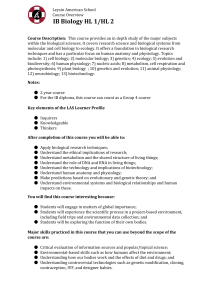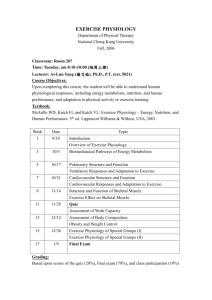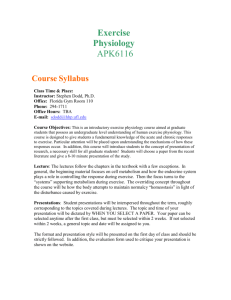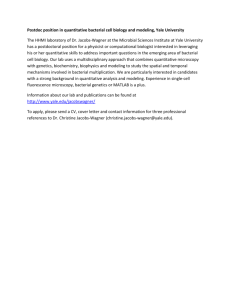Bacterial Cell Structure, Physiology, Metabolism & Genetics
advertisement
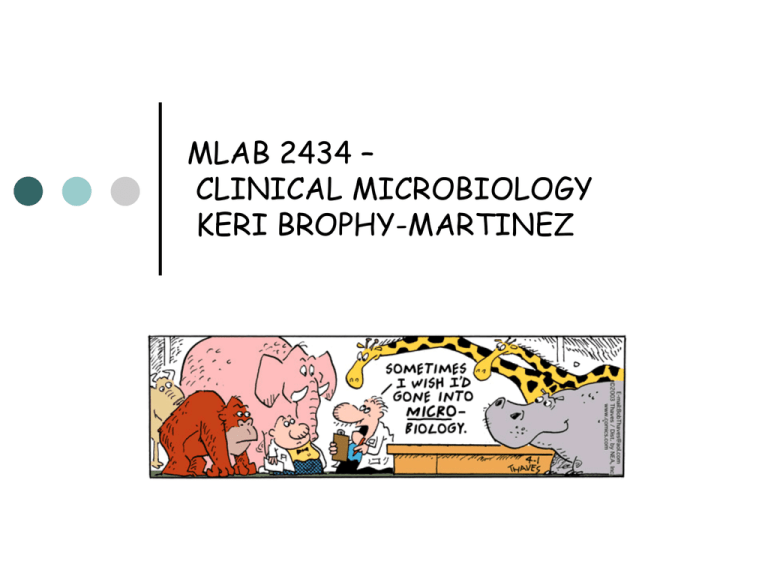
MLAB 2434 – CLINICAL MICROBIOLOGY KERI BROPHY-MARTINEZ Bacterial Cell Structure, Physiology, Metabolism, & Genetics Taxonomy Defined as the orderly classification & grouping of organisms into categories Based on genotype and phenotype Kingdom, Division, Class, Order, Family, Tribe, Genus and Species ( these are the formal levels of classification) • Family = “Clan”; has “–aceae” ending • Genus = “Human last name” • Species = “Human first name” Bacterial Cell Structure, Physiology, Metabolism, & Genetics (cont’d) Nomenclature Family names: Capitalized with “aceae” endings Genus names: Capitalized • When in print, genus and species are italicized. (Staphylococcus aureus) • When written, genus and species are underlined. (Staphylococcus aureus) Species names • Staphylococcus sp. is used when referring to the genus as a whole when the species is not identified. • Can be referred to as singular or plural • “sp.” – singular (Staphylococcus sp.) • “spp.” – plural (Staphylococcus spp.) Abbreviations • First letter of the genus, followed by a period and the species epithet • Ex: Staphylococcus aureus changes to S. aureus Bacterial Cell Structure, Physiology, Metabolism, & Genetics (cont’d) Bacteria Identification – test each bacterial culture for a variety of metabolic characteristics and compare the results with known results. All organisms are either “prokaryotes”, “eukaryotes”, or “archaeobacteria” Bacterial Cell Structure, Physiology, Metabolism, & Genetics (cont’d) PROKARYOTES bacteria Do not have a membrane-bound nucleus DNA is a single circular chromosome Have both cell (plasma) membrane AND cell wall. F= flagellum C=capsule P= pili N= nuclear info R=ribosome CM= cytoplasmic membrane CW= cytoplasmic wall Bacterial Cell Structure, Physiology, Metabolism, & Genetics (cont’d) EUKARYOTES fungi, algae, protozoa, animal cells, and plant cells Cells have nuclei that contains DNA and are complex Most cells do NOT have a cell wall V=Vesicle M=Mitochondria G= Golgi NM= nuclear membrane N= nucleus NC= nucleolus RER= rough endoplasmic reticulum PM= plasma membrane Bacterial Cell Structure, Physiology, Metabolism, & Genetics (cont’d) Archaeobacteria Resembles eukaryotes Found in microorganisms that grow under extreme environmental conditions Cell wall lacks peptidoglycan Bacterial Cell Structure, Physiology, Metabolism, & Genetics (cont’d) Bacterial Cell Wall Bacterial Cell Structure, Physiology, Metabolism, & Genetics (cont’d) Gram Positive (GP) Cell Wall Very thick protective peptidoglycan layer Many GP antibiotics act by preventing synthesis of peptidoglycan Consists of cross-linked chains of glycan Also contain teichoic acid and lipoteichoic acid these unique structures makes these bacteria GP Bacterial Cell Structure, Physiology, Metabolism, & Genetics (cont’d) Gram Negative (GN) Cell Wall Two layers; outer is much thinner than GP cell walls Outer wall contains several molecules, including Lipid A which is responsible for producing fever and shock in infections with GN bacteria The Cell Wall Gram Positive Gram Negative Bacterial Cell Structure, Physiology, Metabolism, & Genetics (cont’d) GP cocci in clusters → GN bacilli (rods) → Bacterial Cell Structure, Physiology, Metabolism, & Genetics (cont’d) Acid Fast Cell Wall – mainly Mycobacteria and Nocardia Have a GP cell wall structure but also a waxy layer of glycolipids and fatty acids (mycolic acid) Waxy layer makes them difficult to gram stain Cannot be decolorized by acidalcohol, hence the name “acid fast” Bacterial Cell Structure, Physiology, Metabolism, & Genetics (cont’d) Absence of Cell Wall – mainly Mycoplasma and Ureaplasma Lack of cell wall results in a variety of shapes microscopically Contain sterols in cell membrane Bacterial Cell Structure, Physiology, Metabolism, & Genetics (cont’d) Some bacteria produce a capsule Protect the bacteria from phagocytosis Capsule usually does not stain, but can appear as a clear area (halo-like) Bacterial Cell Structure, Physiology, Metabolism, & Genetics (cont’d) Some bacteria produce slime layers Made of polysaccharides Inhibit phagocytosis Aid in adherence to host tissue or implants Bacterial Cell Structure, Physiology, Metabolism, & Genetics (cont’d) Cell Appendages Flagella – exterior protein filaments that rotate and cause bacteria to be motile • Polar • Extend from one end • Can occur singly or in multiple tufts • Peritrichous • Flagella found on all sides of bacteria Pili (fimbriae) – hairlike projections that aid in attachment to surfaces Examples of Flagella Bacterial Cell Structure, Physiology, Metabolism, & Genetics (cont’d) Microscopic Shapes Cocci (spherical) Bacilli (rod-shaped) Spirochetes (helical) Groupings Singly Pairs Clusters Chains Palisading Bacterial Cell Structure, Physiology, Metabolism, & Genetics (cont’d) Bacterial Cell Structure, Physiology, Metabolism, & Genetics (cont’d) Size and length Short Long Filamentous Fusiform Curved Pleomorphic Bacterial Cell Structure, Physiology, Metabolism, & Genetics (cont’d) Common Bacterial Stains Gram Stain: • cell wall structure determines the staining characteristics • Procedure to be covered in lab Acid-fast • stains bacteria with high lipid and wax content in their cell walls Bacterial Cell Structure, Physiology, Metabolism, & Genetics (cont’d) Acridine Orange • stains nucleic acid of both G+ and Gbacteria, either living or dead used to locate bacteria in blood cultures and other specimens where background material obscures gram stains Bacterial Cell Structure, Physiology, Metabolism, & Genetics (cont’d) Methylene Blue stain for Corynebacterium diphtheriae to show metachromatic granules and as counter-stain in acid-fast stain procedures Lactophenol Cotton Blue fungal stain Calcofluor White fungal stain Bacterial Cell Structure, Physiology, Metabolism, & Genetics (cont’d) India Ink – negative stain for capsules, surrounds certain yeasts I NEED A BREAK!!!!! Bacterial Cell Structure, Physiology, Metabolism, & Genetics (cont’d) Microbial Growth and Nutrition Needs Source of carbon for making cellular constituents Source of nitrogen for making proteins Source of energy (ATP) for cellular functions Smaller amounts of other molecules Bacterial Cell Structure, Physiology, Metabolism, & Genetics (cont’d) Nutritional Requirements for Growth Autotrophs (lithotrophs) • Able to grow simply, using only CO2, water and inorganic salts • Obtain energy via photosynthesis or oxidation of inorganic compounds • Occur in nature and do not normally cause disease Bacterial Cell Structure, Physiology, Metabolism, & Genetics (cont’d) Heterotrophic • Require more complex substances for growth • Require an organic source of carbon and obtain energy by oxidizing or fermenting organic substances • All human bacteria fall in this category • Within this group, nutritional needs vary greatly Bacterial Cell Structure, Physiology, Metabolism, & Genetics (cont’d) Types of Growth/Culture Media Minimal medium – simple; not usually used in diagnostic clinical microbiology Nutrient medium – made of extracts of meat or soy beans Enriched medium – nutrient medium with extra growth factors, such as blood which encourages small numbers of organisms to flourish Broths- used to detect small numbers of aerobes, anaerobes and microaerophiles Bacterial Cell Structure, Physiology, Metabolism, & Genetics (cont’d) Nonselective medium- supports growth of most nonfastidious microbes. Selective medium – contains additives that inhibit the growth of some bacteria while allowing others to grow Differential medium – contains additives that allow visualization of metabolic differences in bacteria Transport medium – holding medium to preserve those bacteria present but does not allow multiplication Bacterial Cell Structure, Physiology, Metabolism, & Genetics (cont’d) Selection of primary culture media will vary from lab to lab Selection of primary media will depend on anatomical site Bacterial Cell Structure, Physiology, Metabolism, & Genetics (cont’d) Environmental Factors Influencing Growth pH – most media is between 7.0 and 7.5 Temperature – most pathogens grow at body temperature; grown at 35° C in the lab • Psychrophiles: cold temperatures • 10-20o C • Mesophiles moderate temperatures • 20-40 o C • Thermophiles: high temperatures • 50-60 o C Bacterial Cell Structure, Physiology, Metabolism, & Genetics (cont’d) Gaseous composition • Obligate aerobes – require oxygen • Obligate anaerobes – cannot grow in the presence of oxygen • Facultative anaerobes – can grow with or without oxygen • Microaerophilic- grow better in low oxygen environments ( about 20%) • Aerotolerant anaerobes- grows better in the absence of oxygen • Capnophilic – grow better with extra CO2 (5-10%) Bacterial Cell Structure, Physiology, Metabolism, & Genetics (cont’d) Bacterial Growth Reproduce by binary fission Can be fast (as little as 20 minutes for E. coli or slow as 24 hours for M. tuberculosis Bacterial Cell Structure, Physiology, Metabolism, & Genetics (cont’d) Determination of Numbers Direct counting under microscope • Estimates number of live and dead cells Direct plate count • Determines the number of CFU (colony-forming units) in broth cultures and urine cultures Density measurement • Useful to prepare inoculums for antimicrobial susceptibility testing Is It Time For a Break? Bacterial Cell Structure, Physiology, Metabolism, & Genetics (cont’d) Bacterial Biochemistry and Metabolism Metabolic reactions cause production of energy in form of ATP Identification systems analyze unknown specimens for: • Utilization of variety of substances as a source of carbon • Production of specific end products from various substrates • Production of acid or alkaline pH in the test medium Bacterial Cell Structure, Physiology, Metabolism, & Genetics (cont’d) Fermentation and Respiration (Oxidation) Fermentation • Anaerobic process in obligate and facultative anaerobes • The electron acceptor is an organic compound • Does NOT require oxygen Bacterial Cell Structure, Physiology, Metabolism, & Genetics (cont’d) Respiration (Oxidation) • More efficient energy-generating process • Molecular oxygen is the final electron acceptor • Aerobic process in obligate aerobes and facultative anaerobes Bacterial Cell Structure, Physiology, Metabolism, & Genetics (cont’d) Metabolic Pathways Embden-Meyerhoff-Parnas • Primary cycle for bacteria • Convert glucose to pyruvic acid, a key intermediate • Generates energy in the form of ATP Pentose Phosphate pathway Entner-Doudoroff pathway Bacterial Cell Structure, Physiology, Metabolism, & Genetics (cont’d) From pyruvic acid: Alcoholic fermentation (ethanol) Homolactic fermentation (lactic acid) Heterolactic fermentation (lactic acid, CO2, alcohols, formic and acetic acids Propionic acid (propionic acid) Mixed acid fermentation (lactic, acetic, succinic, and formic) Butanediol fermentation(acetoin and 2,3 butanediol) Butyric acid fermentation (butyric) Bacterial Cell Structure, Physiology, Metabolism, & Genetics (cont’d) Main oxidative pathway is the Krebs Cycle, resulting in acid and CO2 Carbohydrate Utilization & Lactose Fermentation “Sugars” = carbohydrates Lactose fermentation – key component in identification schemes Lactose is converted to glucose, so ALL lactose fermenters also ferment glucose Bacterial Cell Structure, Physiology, Metabolism, & Genetics (cont’d) Genetic Elements and Alterations Plasmid • Extra piece of DNA • Code for antibiotic resistance and other virulence factors are often found on plasmids • Sometimes passed from one bacterial species to another. This is how resistance is acquired. Bacterial Cell Structure, Physiology, Metabolism, & Genetics (cont’d) Plasmid replication Three methods • Transformation • Transduction • Conjugation Bacterial Cell Structure, Physiology, Metabolism, & Genetics (cont’d) Mutations “They don’t always read the book” Changes that occur in the DNA code Results in changes in the coded protein or in the prevention of its synthesis References Engelkirk, P., & Duben-Engelkirk, J. (2008). Laboratory Diagnosis of Infectious Diseases: Essentials of Diagnostic Microbiology . Baltimore, MD: Lippincott Williams and Wilkins. http://andyannie.pbworks.com/w/page/5454436/Reproduction http://animals.howstuffworks.com/fish/eels-slippery1.htm http://fanaticstars.wordpress.com/2009/04/01/on-break/ http://www.istockphoto.com/stock-illustration-82213-coffee-break.php http://pathmicro.med.sc.edu/infectious%20disease/infectious%20disease%2 0introduction.htm http://realneo.us/content/yellowstone-national-park-hit-swarm-earthquakes Mahon, C. R., Lehman, D. C., & Manuselis, G. (2011). Textbook of Diagnostic Microbiology (4th ed.). Maryland Heights, MO: Saunders.
